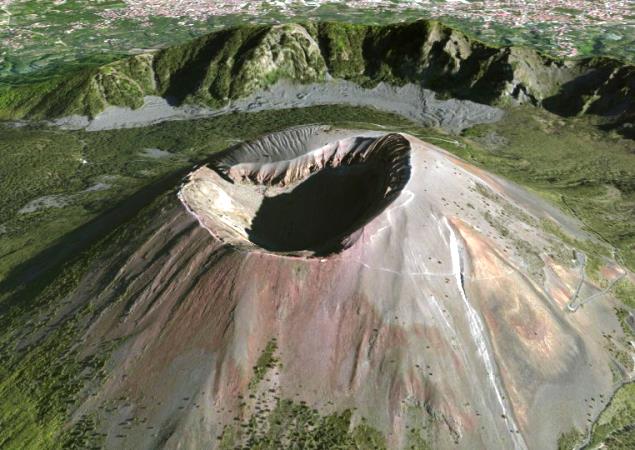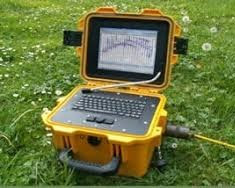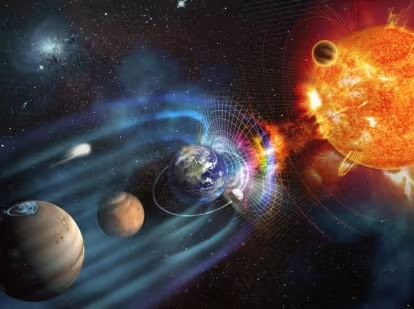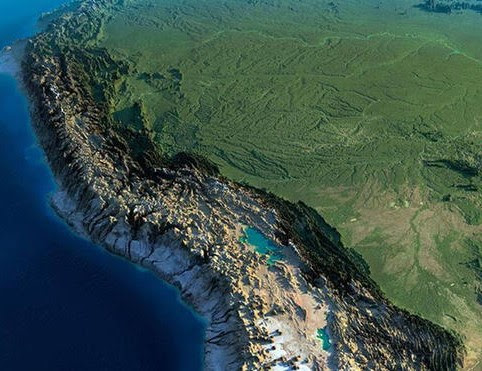GEOPHYSICS
Several years ago the man always tried to imagine what the interior of our planet , as was previously believed that only God's work know these things , but always human curiosity reached limits beyond what was thought , so the man tried to idealize assumptions and ideas of how it would be the interior of our planet.
That reminds me of a well known by all of us, the Core, a mission to the center of the Earth to restore the dynamic movement of the nucleus to again generate the planet 's magnetic field movie, this journey would traverse the crust, mantle and finally reach the nucleus. They were discovering things you never got to see (obviously it was a movie).
But in these present years, man has created methods by which you can study more explicitly inside the Earth, perhaps not as exactly as one would like , but with some positive approach .
"What if the core is made of cheese ? 's Just speculation ... " (Dialogue taken from the Core Movie )
Currently scientists and geophysicists using direct and indirect methods , such as studying the Seismic Waves crossing our crust and mantle , thermal gradients of temperature , seismic tomography, analysis of magma, can study with more precision what materials are formed inside our planet at certain depths and what are its characteristics .
The seismic method is a good tool to study the topic. Whether the seismic method is to study changes in propagation velocity of seismic waves as they vary their speed when passing through different means of different physical composition or when they have a different state of aggregation.
But there may also be other different methods to study the interior of our planet as creating geomechanical models giving us an overview of what might be inside.
Then one can peguntar , how can we study the interior of our planet?
We have previously published that direct and indirect methods we can try to have an approximation of what the inside of the Earth. We explain more .
As direct methods , we can study the inclusions , which are small fragments that appear in the other rocks and igneous rocks ( granites ) or volcanic ( basalt ) . How and where can we find these listings ?
Igneous rocks come from the solidification of a magma . A magma is a mixture of molten rock, water , gas and solid rock fragments produced by melting rock , rock generally melts in the mantle or the base of the crust . When magma rises ( because it is less dense than the rocks that are above him, like a balloon in the air ) can drag or carry rock fragments very deep places . Here are the inclusions , and are studying how studying the geology of Earth's interior . (1)
Now , studying magmatic rocks , you can know how much of the chemistry of the deeper layers of the Earth, we call this Geochemistry , who also used to study the Earth's interior . (1)
O also have the opportunity to study the Earth's interior with the so called diamond drilling and based on subsurface materials extracted directly from both the surface and below it. We take these materials (samples), transported to the laboratory and carry them to the physical and chemical tests . (1) But one of the drawbacks of this method is the depth of drilling, as it has allowed us to dig a little over the first 12 km. Quite aside from the large amount of time used to get to the core .
And as indirect methods we can study the Heated Flows , which is simply the heat emission of the Interior of the Earth and at the same time can be generated by the friction of the layers of the Earth, exothermic chemical reactions, decays of radioactive elements , by the changes of state of the material . (1)
The heat emitted by the earth has an average value but when measured at different points different values are obtained . We can say that high values of heat flow are in -ocean ridges , where plate boundaries are active, where the crust is thinner and where the materials are more modern . (1)
And values are low heat flow in oceanic trenches , ranging from inactive license, where the crust is thicker and where materials are older . By the difference in heat flux deduce that the interior of the Earth is not homogeneous. (1)
We also study the force of gravity , which is nothing but the force with which bodies attract , being directly proportional to the masses of those bodies and inversely proportional to the square of the distance to be found.
When measuring the severity in different parts of the world obtain different values , this indicates that the interior of the Earth is heterogeneous , ie which is formed by layers of materials of different nature. There is a theoretical value of gravity for the entire planet , when the measured data does not match the theory says that there is a gravity anomaly . These anomalies can be:
Positive anomalies: the measured value is greater than the expected (theoretical ) , indicating that at that point , below the surface there are materials with a high density . And negative anomalies where the measured value is less than the expected (theoretical ) , indicating that at that point , below the surface there are materials with a low density.
The study of gravity anomalies to deduce the existence of a fluid layer in the Earth's interior .
The study of meteorites allows us to analyze the composition of the rock that is formed this body , since its origin in this way is similar to Earth. This is based on the solar system is composed of the same materials, by which our planet -forming materials have similar characteristics of meteorites .
One of the indirect methods that have had better results than the previous studies are the propagation of seismic waves when earthquakes occur .
Seismic waves ( vibrations caused by an earthquake) are generated at the epicenter of the earthquake and propagate both the exterior and the interior of the Earth.
The study of wave velocity and their paths have brought to the Earth's interior (composition, physical state and structure) , since the wave behavior changes depending on the properties and nature of the rocks that cross . (2)
Seismic waves that travel through the Earth's interior ( P and S ) suffer deviations in trajectory (refraction ) . Each trajectory change reflects a change in the composition or condition of the materials passing through . That area is called exchange material discontinuity. (2) the study of seismic waves allowed us to distinguish the Internal Structure of the Earth and its crust , mantle and core .
In addition to using a tool such as the Applied Geophysics , which allows us to study different ways inside our planet. Depending on the method used may have a greater depth of investigation.
The methods used by the Geophysics to try to study the Earth's interior are the Seismic Refraction, the Vertical Electrical Soundings , Gravimetry , Electric scans or GeoRadar .
From all this we take to determine what is and what is the structure of the Earth, which we all know from already very small .
LITERATURE REFERENCE
( 1) http://cienciaconpaciencia.blogspot.com/2009/08/como-se-puede-conocer-la-geologia-del.html
(2) http://e-ducativa.catedu.es/44700165/aula/archivos/repositorio//500/564/html/Unidad02/pagina_1.html
"Any questions, concerns , questions or comments write to marvar26@gmail.com "
Several years ago the man always tried to imagine what the interior of our planet , as was previously believed that only God's work know these things , but always human curiosity reached limits beyond what was thought , so the man tried to idealize assumptions and ideas of how it would be the interior of our planet.
 |
| Professor of Geophysics . " The Core " |
But in these present years, man has created methods by which you can study more explicitly inside the Earth, perhaps not as exactly as one would like , but with some positive approach .
"What if the core is made of cheese ? 's Just speculation ... " (Dialogue taken from the Core Movie )
Currently scientists and geophysicists using direct and indirect methods , such as studying the Seismic Waves crossing our crust and mantle , thermal gradients of temperature , seismic tomography, analysis of magma, can study with more precision what materials are formed inside our planet at certain depths and what are its characteristics .
The seismic method is a good tool to study the topic. Whether the seismic method is to study changes in propagation velocity of seismic waves as they vary their speed when passing through different means of different physical composition or when they have a different state of aggregation.
But there may also be other different methods to study the interior of our planet as creating geomechanical models giving us an overview of what might be inside.
Then one can peguntar , how can we study the interior of our planet?
We have previously published that direct and indirect methods we can try to have an approximation of what the inside of the Earth. We explain more .
As direct methods , we can study the inclusions , which are small fragments that appear in the other rocks and igneous rocks ( granites ) or volcanic ( basalt ) . How and where can we find these listings ?
Igneous rocks come from the solidification of a magma . A magma is a mixture of molten rock, water , gas and solid rock fragments produced by melting rock , rock generally melts in the mantle or the base of the crust . When magma rises ( because it is less dense than the rocks that are above him, like a balloon in the air ) can drag or carry rock fragments very deep places . Here are the inclusions , and are studying how studying the geology of Earth's interior . (1)
Now , studying magmatic rocks , you can know how much of the chemistry of the deeper layers of the Earth, we call this Geochemistry , who also used to study the Earth's interior . (1)
O also have the opportunity to study the Earth's interior with the so called diamond drilling and based on subsurface materials extracted directly from both the surface and below it. We take these materials (samples), transported to the laboratory and carry them to the physical and chemical tests . (1) But one of the drawbacks of this method is the depth of drilling, as it has allowed us to dig a little over the first 12 km. Quite aside from the large amount of time used to get to the core .
And as indirect methods we can study the Heated Flows , which is simply the heat emission of the Interior of the Earth and at the same time can be generated by the friction of the layers of the Earth, exothermic chemical reactions, decays of radioactive elements , by the changes of state of the material . (1)
The heat emitted by the earth has an average value but when measured at different points different values are obtained . We can say that high values of heat flow are in -ocean ridges , where plate boundaries are active, where the crust is thinner and where the materials are more modern . (1)
And values are low heat flow in oceanic trenches , ranging from inactive license, where the crust is thicker and where materials are older . By the difference in heat flux deduce that the interior of the Earth is not homogeneous. (1)
We also study the force of gravity , which is nothing but the force with which bodies attract , being directly proportional to the masses of those bodies and inversely proportional to the square of the distance to be found.
When measuring the severity in different parts of the world obtain different values , this indicates that the interior of the Earth is heterogeneous , ie which is formed by layers of materials of different nature. There is a theoretical value of gravity for the entire planet , when the measured data does not match the theory says that there is a gravity anomaly . These anomalies can be:
Positive anomalies: the measured value is greater than the expected (theoretical ) , indicating that at that point , below the surface there are materials with a high density . And negative anomalies where the measured value is less than the expected (theoretical ) , indicating that at that point , below the surface there are materials with a low density.
The study of gravity anomalies to deduce the existence of a fluid layer in the Earth's interior .
The study of meteorites allows us to analyze the composition of the rock that is formed this body , since its origin in this way is similar to Earth. This is based on the solar system is composed of the same materials, by which our planet -forming materials have similar characteristics of meteorites .
 |
| Interior of the Earth Seismic Waves. |
Seismic waves ( vibrations caused by an earthquake) are generated at the epicenter of the earthquake and propagate both the exterior and the interior of the Earth.
The study of wave velocity and their paths have brought to the Earth's interior (composition, physical state and structure) , since the wave behavior changes depending on the properties and nature of the rocks that cross . (2)
Seismic waves that travel through the Earth's interior ( P and S ) suffer deviations in trajectory (refraction ) . Each trajectory change reflects a change in the composition or condition of the materials passing through . That area is called exchange material discontinuity. (2) the study of seismic waves allowed us to distinguish the Internal Structure of the Earth and its crust , mantle and core .
In addition to using a tool such as the Applied Geophysics , which allows us to study different ways inside our planet. Depending on the method used may have a greater depth of investigation.
The methods used by the Geophysics to try to study the Earth's interior are the Seismic Refraction, the Vertical Electrical Soundings , Gravimetry , Electric scans or GeoRadar .
From all this we take to determine what is and what is the structure of the Earth, which we all know from already very small .
LITERATURE REFERENCE
( 1) http://cienciaconpaciencia.blogspot.com/2009/08/como-se-puede-conocer-la-geologia-del.html
(2) http://e-ducativa.catedu.es/44700165/aula/archivos/repositorio//500/564/html/Unidad02/pagina_1.html
"Any questions, concerns , questions or comments write to marvar26@gmail.com "































0 Comments:
Publicar un comentario
No olvides de escribir tu opinión personal de nuestro blog, una página o información que desees comprtir. Todos los éxitos para ti. Gustavo Zavala.